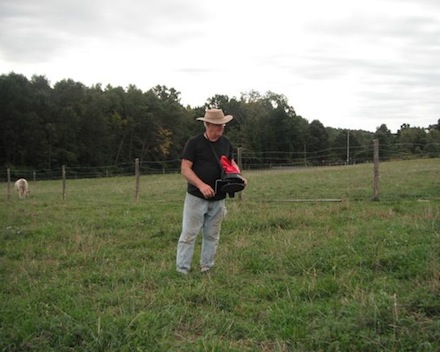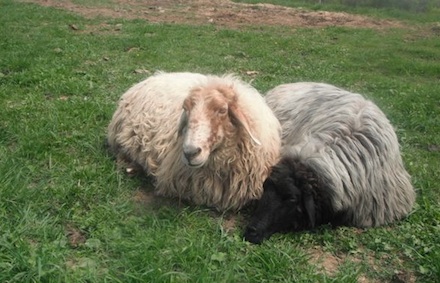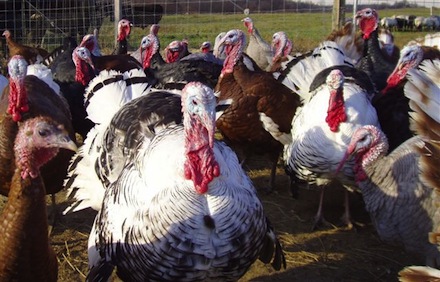
AgriCulture bloggers Peter Davies and Mark Scherzer are the owners of Turkana Farms in Germantown, NY. This week Peter writes. “Sustainability,” a word that often comes up in regard to the new directions in farming, has come to mind a few times recently. In particular I have wondered how sustainable what we are doing is. Time to take an accounting. A careful stewardship of the land would seem to me to be a primary goal in sustainability. We began 11 years ago with most of our acreage in a very poor state, having recently been bulldozed to clear it of orchards and vineyards. (This happened a few years before we purchased the farm). In the interim, the major part of the bulldozed land had grown up with a random mix of weeds, grasses, and shrubs, and the rest of the acreage was an exhausted hay field. (It had been hayed for a number of years but never fertilized, limed, or seeded).

Essentially we had no real pasture, leaving us with two choices: plow everything up and seed it with pasture grasses, legumes, and alfalfa; or accept what was there and through introducing grazing animals — which would fertilize it — and infilling with pasture seed, gradually create good pasturage. Following some good advice, we chose the second path and purchased the first year a motley bunch of feeder beef cows to start the process. (We would not get a premier breed until we had good enough pasture for them to thrive on.) An adult cow, we had learned, drops around 40 pounds of manure a day, and grazes about the same poundage in grasses. By allowing our six cows to range free over the pasture, spreading 240 pounds of manure a day as they foraged, we were able to rejuvenate the soil, while each spring and fall we infilled by broadcasting hundreds of pounds of grass, clover, and alfalfa seed. We gradually arrived at two of the three key ingredients needed for good grazing: rich soil and good forage, while nature provided the third, sunshine. Thus in a very organic way we achieved our goal of creating decent pasture capable of sustaining a small herd of cows and a medium-sized herd of sheep. Improving our pasture remains an ongoing process that we and the animals daily work in partnership on.

We currently continue on the road to sustainability by not confining our grazing animals in paddocks or feedlots but allowing them to freely range over our pastureland, thus obviating the need for chemical fertilizers and avoiding the contamination and dangers of disease that arise from the manure build up that inevitably results when animals are confined. Also obviated is the need for antibiotics and other medications to prevent the diseases to which confined, grain-fed animals are prone. Only in winter, in severe weather, when the cows and sheep take shelter in the cowshed and barn, is there any threat of a manure build-up, and these nightly deposits can be removed to the compost pile with diligent pitchforking on a daily basis. But with winter we arrive at one strike against our sustainability — our need to purchase hay to get the herds through the season. Ideally, to be sustainable we would be producing our own hay and feeds, but with only just under 40 acres we have maxed out our acres with grazing. An adult cow, for instance, ideally requires about five acres of grazing land. Each winter season we are vulnerable to the vagaries of prices and availability, particularly this year, when regions that normally produce their own hay are, because of the severe drought, reaching into our region for their hay supplies. To get our herds through the winter last year required at least $7500 in hay and baleage. We wonder, with trepidation, what the costs this year might be.

But on other fronts we are highly sustainable. With two wells, we are self-sufficient in water. And we are self-sufficient in compost, with all the manure emanating from our turkeys, geese, ducks, and chickens, as well as the winter droppings of our cows and sheep. Indeed, we have a mountain of self-sufficiency in our compost pile and thus do not need to “import” chemical fertilizers. Our human waste (what Prince Charles calls the “royal sewage”), of course, is recycled beneath the garden lawn in the cesspools. Other waste materials are recycled within the farm: all kitchen scraps go to the pigs and chickens, as does most of the discarded vegetable matter from our vegetable garden. No edible matter leaves the farm headed for the local landfill. Throughout the gardening season, daily cartloads of weeds go to the chickens, supplementing their daily grain feed. Which brings me to our other vulnerability. As we do not have space for hay fields, we likewise cannot grow the corn, soy, and wheat demanded by our poultry and pigs. Leaving us, as with hay, at the mercy of market forces. With, as Mark has already pointed out, two feed price rises already this season, and more to come, our dependence on “importing” grain into the farm poses a real challenge, particularly as we favor local and, where possible, organic grains freshly ground for our animals. As is now evident, self-sufficiency is an important factor in achieving sustainability.

As you have seen in our bulletin on our Thanksgiving dinner, we pride ourselves on being highly self-sufficient in our diet, as much as possible eating food we produce ourselves, and restricting “imports” primarily to food items we are not able to produce. With the savings we realize we are helping to make our farm effort sustainable. Which brings me to another aspect of our sustainability: consumer support. While requests to be included in our weekly bulletin mailings continue to increase, which we greatly appreciate, we have noticed a drop-off in farm purchases and a slowness to make reservations for farm products. We don’t know whether this slowdown is attributable to problems with the economy, or whether the novelty of purchasing directly from the farm is wearing off, or whether the convenience of stores is just irresistible, but whatever the cause, a decline in farm income coupled with a substantial increase in farm costs endangers the sustainability of all small-scale family farms, like Turkana Farms. —Peter Davies









